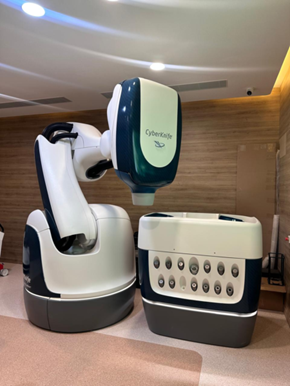SBRT Treatment in India
Radiation therapy plays a crucial role in modern cancer treatment, offering an effective way to target and destroy cancer cells. Among the most advanced techniques available today is Stereotactic Body Radiation Therapy (SBRT), a highly precise treatment that delivers high doses of radiation to tumors while sparing surrounding healthy tissue.
This innovative approach has become a game-changer in treating cancers in areas such as the lungs, liver, pancreas, brain, spine, and prostate, significantly improving patient outcomes. SBRT is also highly effective in managing metastases, including brain, lung, liver, spine, and bone metastases, further expanding its reach in treating complex cases.
Dr. Sridhar Papaiah Susheela, a leading radiation oncologist is at the forefront of SBRT treatment in India. With over 5000 SBRT procedures and counting, Dr. Sridhar’s expertise ensures that patients receive the most precise and effective care.
His experience and commitment to cutting-edge technology make him a trusted radiation oncologist in India, delivering optimal results for complex cancer cases.

Learn more about how SBRT can target your cancer with precision – contact an experienced radiation oncologist for detailed information.
Wondering how modern technology is transforming cancer treatment? Let’s explore SBRT radiation treatment.
The SBRT treatment process
Stereotactic body radiation therapy (SBRT) is a highly advanced form of radiation therapy, designed to treat cancerous tumors with exceptional precision. Unlike conventional radiation therapy, which involves delivering low doses over many sessions, SBRT administers very high doses in fewer treatments—typically 1 to 6 sessions.
The hallmark of SBRT is its pinpoint accuracy, minimizing damage to surrounding healthy tissues. This is achieved through sophisticated imaging technologies like CT, MRI, or PET scans, which help doctors locate and outline the tumor in three dimensions. Once mapped out, radiation beams are delivered from multiple angles to concentrate the dose on the tumor itself.

SBRT started as a treatment for smaller, single lesions but has now evolved. It can be used for multiple tumors of varying sizes, depending on the treating physician’s discretion. While SBRT can be performed using any linacs (Linear Accelerators) equipped with image-guided technology and a Micro Multileaf Collimator, SBRT by CyberKnife is considered the best in class. The Cyberknife treatment in India offers unparalleled precision, especially for challenging or complex cases, thanks to its robotic technology and real-time imaging.
This cutting-edge treatment is especially useful for tumors in areas where surgery may be risky or inoperable, such as the lungs, brain, pancreas, liver, and prostate. Its non-invasive nature, shorter treatment duration, and high success rates make SBRT a preferred option for many cancer patients.
Now, let’s understand the SBRT CyberKnife process step by step
What should I expect during and after SBRT treatment?
Initial consultation and planning:
The treatment journey begins with a thorough consultation. Imaging scans, such as CT, MRI, or PET, are performed to precisely locate the tumor. Dr. Sridhar PS, a renowned radiation oncologist in India, and his medical team will then create a detailed treatment plan. This plan maps out the exact areas to be targeted, ensuring minimal exposure to surrounding healthy tissues.

Immobilization and positioning:
To ensure the patient remains perfectly still during treatment, customized immobilization devices may be used. These help to keep the body in the same position throughout the sessions, which is crucial for the precision of SBRT.
Treatment simulation:
A simulation is often performed before the actual treatment. This allows the team to rehearse the treatment setup and ensure the radiation will be delivered accurately. This step ensures that everything is set up correctly for the actual therapy.
Radiation delivery:
SBRT involves 1 to 6 sessions, but in some cases, treatment can extend to more sessions, depending on the tumor size and complexity. Each session lasts 30-60 minutes. Using advanced technology like CyberKnife, highly focused radiation beams are directed at the tumor from multiple angles, providing maximum impact on cancer cells while sparing healthy tissues. CyberKnife is especially valuable in cases where the tumor is inoperable, inaccessible, recurrent, or when patients prefer to avoid surgery. It can also be used for re-irradiation and is suitable for patients of any age, size, or gender.
Post-treatment monitoring:
After SBRT, patients will have regular follow-up appointments to monitor the effectiveness of the treatment. Imaging scans will help assess the tumor’s response, and any potential side effects are managed by the medical team. Most patients experience fewer side effects compared to traditional radiotherapy, with some mild fatigue or temporary discomfort being common.
Recovery and support:
Patients can resume their normal activities shortly after treatment. Our team provides support and guidance throughout your recovery, addressing any concerns and helping you manage any symptoms that may arise.
Discover if stereotactic radiation therapy is right for you – Book an appointment with a radiation oncologist today!
The success rate for SBRT radiation
SBRT has shown impressive success rates, particularly for early-stage and localized cancers. For tumors in areas such as the lungs, liver, and prostate, SBRT offers a tumor control rate of 85% to 95%. Its high precision and targeted approach result in fewer complications and reduced side effects, allowing for better patient outcomes. The success rate depends on several factors, including tumor type, size, and location, but overall, SBRT treatment in India has become a leading choice for treating cancers that are difficult to reach surgically or for patients who are not ideal candidates for surgery. Regular follow-ups and imaging scans post-treatment help to ensure long-term success.

Read on to find out how much SBRT treatment might cost in India.
What is the cost of SBRT treatment in India?
The cost of SBRT treatment in India can vary based on several factors, including the type and location of the cancer, the extent of the disease, the number of treatment areas, and the technology or machine used, such as CyberKnife. Generally, the cost of SBRT treatment ranges from ₹.2,50,000 to ₹8,00,000.
While this cost is still more affordable compared to Western countries, the final amount will depend on the complexity of your case, the number of sessions required, and any additional medical support during the treatment. For a personalized estimate, it is best to consult your oncologist, who can provide specific details based on your condition.

Let’s meet the leading expert in precision radiation therapy and CyberKnife treatment in India.
Dr. Sridhar Papaiah Susheela
Prof. Dr. Sridhar Papaiah Susheela is a highly experienced radiation oncologist with over 26 years of expertise. Practicing in Bangalore, Chennai, and Mumbai, he is renowned for his advanced skills in IMRT, SBRT, and CyberKnife treatment in India. Dr. Sridhar has treated more than 10,000 patients globally, including over 5000 with SBRT, making him a leading specialist in SBRT radiation therapy.
He completed his MBBS from Mysore University, followed by an MD in Radiotherapy from Banaras Hindu University, and a DNB in Radiotherapy. Dr. Sridhar also received advanced training at Stanford University. With more than 200 publications to his name, and extensive experience and pioneering work in high-precision radiotherapy and oncology imaging, he remains a prominent figure in cancer treatment.
Risks or side effects associated with SBRT
While SBRT is generally a well-tolerated and non-invasive procedure, like any treatment, it may have some side effects. One of the main advantages of SBRT is that it does not require anesthesia, leaves no scars, and is highly accepted by patients—over 95% of patients tolerate the treatment very well.
Some may have minimal side effects like fatigue, swelling, or skin irritation. Long-term side-effects though rare may include changes in organ function or tissue damage, depending on the area being treated.
Ready to explore advanced cancer treatment options? Contact an expert oncologist to discuss your personalized SBRT radiation treatment plan.
Metastatic Directed Therapy Combining Treatments for Long-Term Survival
Metastatic Directed Therapy (MDT) is an evolving treatment approach that focuses on targeting metastatic cancer lesions with the goal of extending patient survival. By combining advanced genomics, immunotherapy, and SBRT, MDT is designed to deliver highly personalized treatment to both primary and metastatic tumor sites. This multidisciplinary strategy not only aims to control cancer growth but also enhances the effectiveness of each treatment modality.
With the precision of SBRT in targeting tumors, combined with genomics-driven therapies and immune system-enhancing treatments, MDT offers hope for patients with metastatic disease. The objective is not just to control cancer but to potentially achieve a decade or more of survival for patients. By focusing on both the primary tumor and metastases, MDT represents a shift toward long-term cancer management and improved quality of life.
Latest research and developments in SBRT radiation
SBRT is continually advancing with new research and technologies enhancing its precision and effectiveness:
- Image-Guided SBRT (IG-SBRT): Advanced imaging like cone-beam CT (CBCT) and MRI-guided radiation therapy (MRgRT) enables real-time tracking of tumors, improving accuracy and reducing radiation exposure to healthy tissues.
- Hypofractionation: This approach delivers larger doses of radiation in fewer sessions, potentially shortening treatment times and improving patient convenience. Ongoing studies are assessing its effectiveness for various cancers.
- SBRT for metastatic disease: SBRT is expanding to treat metastatic lesions, offering promising results for tumor control and survival when other treatments are not viable.
- Combination therapies: Combining SBRT with chemotherapy or immunotherapy can enhance overall treatment outcomes, with personalized plans tailored to individual patient needs.
- Technological advancements: Newer linear accelerators and robotic platforms are improving the precision and delivery of SBRT, making treatments more effective and reducing risks.
FREQUENTLY ASKED QUESTIONS
Stage 4 lung cancer, or metastatic lung cancer, is advanced and typically not curable. However, treatments such as chemotherapy, targeted therapy, immunotherapy, and radiation therapy can manage the disease, shrink tumors, and improve quality of life. While a cure is not generally achievable, these treatments can help extend survival and alleviate symptoms.
SBRT usually begins to show results within a few weeks to a few months after treatment. While the precise timeline can vary based on the type of cancer and individual response, many patients start to notice improvements in their symptoms and tumor shrinkage relatively quickly.
SBRT is ideal for patients with small, localized tumors that are hard to treat with surgery or conventional radiation. It is often recommended for those with early-stage cancers or metastases in areas like the lungs, pancreas, liver, or prostate, and who are in good overall health.
- Lung Cancer
- Liver Cancer
- Spine Tumors
- Prostate Cancer
- Kidney Cancer
- Pancreatic Cancer
SBRT can also be applied to other cancers, particularly when the tumors are small, well-defined, and in locations where precise targeting is possible.
